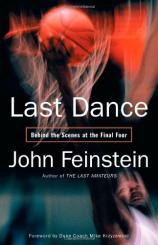Last Dance: Behind the Scenes at the Final Four
Review
Last Dance: Behind the Scenes at the Final Four
Like baseball fans who spend the winter chanting their mantra --- "pitchers and catchers" --- in anticipation of the first day of spring training, college basketball enthusiasts count down the days until March Madness, the tournament to crown the NCAA basketball champions.
The sporting event has become one of the biggest in the country, aided by increased media attention that now includes coverage of all the games, not just those among the teams fighting to be involved in the final face-off.
John Feinstein captures all the tumult in his typically illuminating fashion in LAST DANCE: Behind the Scenes at the Final Four. As in his other books, which encompass baseball, football, basketball, golf and tennis, he focuses on the buildup of the excitement leading up to the championship game rather than dwell on the athletic accomplishments of individual participants.
Feinstein has the ability to entice even those who don't consider themselves sports fans. He makes his subjects human, making them accessible to the level of the average person, while at the same time telling us what makes them remarkable. For example, this anecdote about legendary UCLA coach John Wooden:
"The lobby was still crowded and, as often happens when Wooden crosses a room or a lobby, people stopped what they were doing to watch the great man. At that moment, what they saw was heartbreaking: Wooden pushing his wife's wheelchair, everyone knowing that her time was short.
"To this day, no one is certain how it began, but someone started to clap. Then others did the same thing. By the time the Woodens had reached the elevators, everyone in the lobby was turned in their direction, clapping. It was one of those unrehearsed moments that become remarkable ones."
LAST DANCE is full of such moments, whether it's about coaches and the difficulties of building a winning program or athletes overcoming a range of problems from poverty to violence to academic disadvantages.
College basketball has changed over the years. There was more of a sense of camaraderie in the early days of the tournament. Players and coaches used to mill around the hotel lobby, swapping stories and talking strategy. Now, with hundreds of reporters and broadcasters constantly swimming the waters in search of stories, such innocence is long gone.
Like all high-profile events, the NCAA championships would not be possible without all those spear carriers in the background. Another characteristic of Feinstein's work is to give such supporting casts their due. Referees, college sports information directors (SIDs), boosters, selection committee members ("The committee chairman…is frequently referred to by those interviewing him as "Mr. Chairman," as if he were a member of Congress, not simply someone leading a group charged with picking teams for a basketball tournament."), even the ticket scalpers --- their behind-the-scenes work factors into the success or failure of the colleges' seasons, or the fans' ability to enjoy the spectacle.
Feinstein is most candid when he writes about the desirability (or lack thereof) of the selection of certain schools in the tournament, at least from the point of view of the television decision-makers. While most fans love a Cinderella story, TV is more interested in ratings that high-profile or large-market teams like Duke, North Carolina, Indiana, Syracuse, and Georgetown might bring than some tiny school in Iowa that got lucky.
Fans of college hoops, whether rabid or peripheral, will find LAST DANCE educational, entertaining, and a good way to keep in touch while waiting for the games to begin.
Reviewed by Ron Kaplan on February 7, 2006
Last Dance: Behind the Scenes at the Final Four
- Publication Date: February 7, 2006
- Genres: Nonfiction, Sports
- Hardcover: 384 pages
- Publisher: Little, Brown and Company
- ISBN-10: 031616030X
- ISBN-13: 9780316160308





